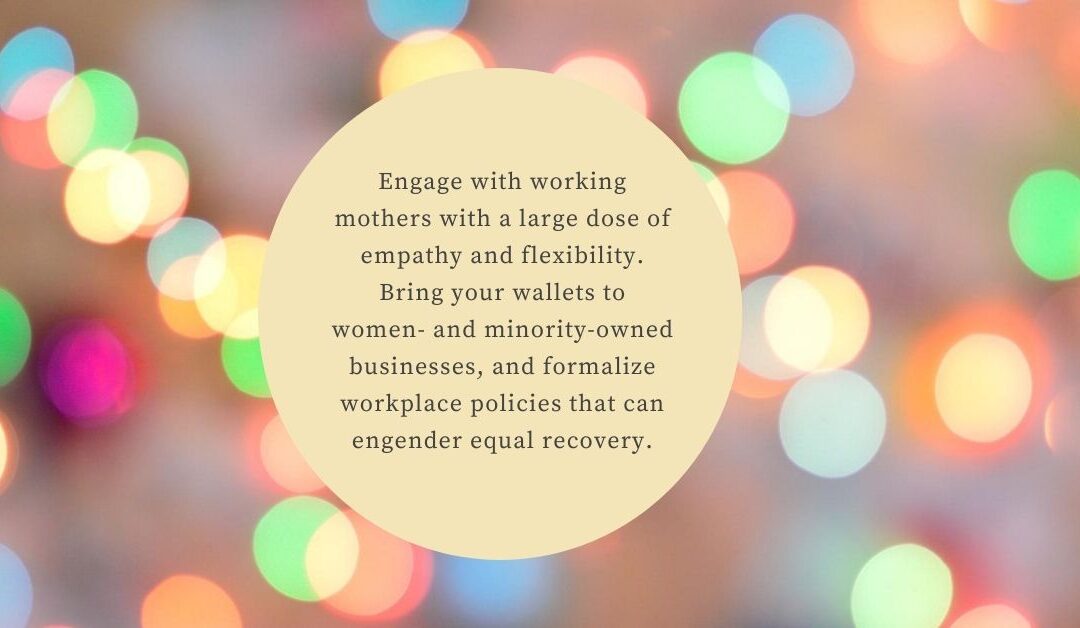In a matter of weeks, women have lost nearly a decade’s worth of progress towards closing the gender wage gap. The culprit is coronavirus. Fractured leadership, inconsistent guidance, and politically motivated decisions have made a terrible situation worse. The painful but necessary shutdown of non-essential businesses, offices, childcare centers, and school buildings were surreal. Our collective impatience to get “back to normal” has spiraled our country into an extended and horrifying embarrassment. Six months in, the virus that has infected every part of our lives and killed nearly 150,000 Americans (and counting), and we face the likelihood that schools will start the school year in a remote or hybrid model, exacerbating a difficult balancing act for families. Men have not been spared the devastating effects of this virus on their lives and livelihoods. Disproportionally though, women have borne the weight of this burden. There is no good option, but the least bad one. Women and families have a Hobson’s choice, and the impact on careers and earnings may take years to recover.
Why is this pandemic particularly impacting women? According to the Institute for Women’s Policy Research, last year we made up the majority of the US workforce for the first time in nearly a decade. There are 23.5 million working mothers with kids under 18—almost a third of the female workforce in the US. Enter COVID. In March and April, women accounted for 55% of the job losses, and more than that in female-dominated sectors such as retail, travel, and hospitality which have been especially hard-hit by pandemic closures. The situation is worse for our Black and Latina peers. The unevenness reflects the fact that women are more likely to work in services that require interacting with people—work that cannot be done from home. Women-owned small businesses are concentrated in customer-facing areas, which is why women founders are much more likely than men to expect a drop in sales owing to COVID-19.
Women are losing jobs at higher rates than men, represent a greater proportion of hourly workers that don’t have paid sick leave, and are shouldering most of the additional housework, childcare, and homeschooling duties. Tens of millions of essential workers can’t work from home, and many of them need childcare in order to do their jobs. Those essential workers are disproportionately women. Higher-skilled women are less likely to lose their jobs but are juggling working from home with child care with some estimates that they’re doing an extra 40 hours of care and schooling a week. If jobs and productivity losses persist, they could reverse progress toward gender and wage equality in the workplace in a staggering way.
“Engage with working mothers with a large dose of empathy and flexibility. Bring your wallets to women- and minority-owned businesses, and formalize workplace policies that can engender equal recovery.”
Even as some parts of the country lift restrictions, working moms report having no choice but to scale back their career ambitions, leave the workforce, or sacrifice their sleep and mental health to juggle work and full-time childcare or homeschooling at the same time. A break from the workforce can hurt the long-term earning potential of a woman, not to mention her peace of mind. Since women earn about 80% of what men do, they are often the ones who end up having to make career sacrifices among dual-income, heterosexual families. Economists say those decisions could result in a catastrophic economic setback for women.
I watch just about every woman I know with kids living at home juggle and struggle through this pandemic. I know many mothers who are trying to make it work by taking care of their kids during the day and working from 9 pm to 2 am most nights just to keep their heads above water at work. The unsustainability of this is pronounced as communities scramble to figure out how to begin the school year. Just over 15 million households nationwide have at least one child between the ages of 5 and 12 who presumably will require some parental supervision. Some nine million households have kids under the age of 5, and 13 million households have kids 13-18 years old. When the pandemic and associated closures of childcare, preschool, and K-12 building happened this spring, we pushed through and juggled. Continued closures of school buildings mean it will be more difficult for parents to get to work or be as productive while they multitask at home. So the prospect of an ongoing need for remote learning is an agonizing prospect for many families. Again, a Hobson’s choice between the health and safety of children and educators (and the families they come home to) or continue juggling and struggling—or for some an unsettling decision for some working mothers to step out of the workforce altogether.
At the risk of admiring the problem without a viable solution, there is indeed a large portion of this that is quite simply in the control of an as-yet-uncontrolled virus exacerbated by a vacuum of leadership and good old American you-can’t-tell-me-what-to-do independent spirit. I encourage leaders to engage with working mothers with a large dose of empathy and flexibility. As we step our way back to reopening, bring your wallets to women- and minority-owned businesses. Instead of frustration and criticism, ask educators how you can help (hint: they’ll tell you to wear a mask). And as employers, we must proactively use the pandemic as an opportunity to examine and formalize workplace policies that can help engender equal recovery, such as paid sick leave, permanent flexible working arrangements, child-care support, and wage equity programs. While we work to flatten the curve (again) on this surging virus, let’s also set our sights on flattening the downward curve in gender equity and earnings.

